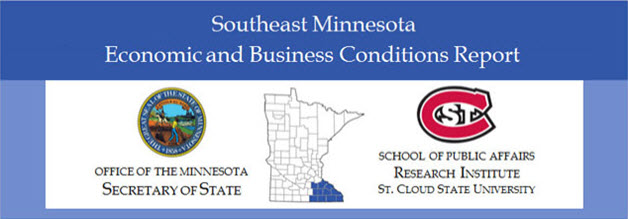Publication Title
Southeast Minnesota Economic and Business Conditions Report
Document Type
Research Study
Publication Date
6-13-2019
Financial Year
2018
Abstract
A slowing of economic growth over the next several months is expected in the Southeast Minnesota planning area according to the prediction of the Southeast Minnesota Index of Leading Economic Indicators (LEI). The leading index fell by 9.81 points in the fourth quarter as all five index components recorded negative values. A decrease in the number of Rochester area residential building permits, a weakening in consumer sentiment, lower new filings of incorporation and LLC, and a decline in the Minnesota Business Conditions Index all helped drive the LEI lower in the fourth quarter. The LEI is now essentially unchanged from one year ago.
There were 804 new business filings with the Office of the Minnesota Secretary of State in Southeast Minnesota in the fourth quarter of 2018 — representing a 4.7 percent reduction from one year ago. 70 new regional business incorporations were filed in the fourth quarter, 48.9 percent more filings than prior year levels. At a level of 498, fourth quarter new limited liability company (LLC) filings in Southeast Minnesota were 5.7 percent lower than in the fourth quarter of 2017. With 182 filings, new assumed name activity was 20.2 percent below what was seen in the same quarter last year. There were thirteen more new filings for Southeast Minnesota non-profit over the last three months compared to one year earlier.
Sixty-one percent of new business filers in the Southeast Minnesota planning area completed the voluntary Minnesota Business Snapshot (MBS) survey in the fourth quarter. Results of this voluntary survey indicate that 7.3 percent of new filers come from communities of color and 6.7 percent are veterans. Only 2 percent of new filers come from the disability community and 4.5 percent of new filings are made by the immigrant community. Nearly forty-one percent of new business filings in Southeast Minnesota in the fourth quarter were initiated by women. MBS results also show that most new business filers in Southeast Minnesota have between 0 and $10,000 in annual gross revenues (although 47 new filers have revenues in excess of $50,000). The most popular industries for new businesses in Southeast Minnesota are retail trade, real estate/rental/leasing, construction and other services. Employment levels at most new firms are between 0 and 5 workers, and 47.6 percent of those starting a new business consider this a part-time activity.
Employment of Southeast Minnesota residents declined by 0.8 percent over the year ending December 2018. The regional unemployment rate was 3.0 percent in December, slightly higher than was recorded one year earlier. Initial claims for unemployment insurance in December 2018 fell by 13.4 percent from one year earlier and the Southeast Minnesota labor force decreased by 0.7 percent. Average weekly wages in Southeast Minnesota rose by 3.9 percent over the past year. The planning area’s annual bankruptcies were 14.4 percent higher than one year ago.
Data from the Rochester area—the largest market in Southeast Minnesota—were mixed. An increase in overall employment (and job gains in the area’s manufacturing and health/education sectors), a larger labor force, and lower initial jobless claims contributed to a favorable outlook for the region. Fewer overall new business filings, lower average hourly earnings, a reduction in average weekly work hours, and a smaller valuation of residential building permits in the Rochester area were negative indicators.
Recommended Citation
Banaian, King and MacDonald, Richard, "Southeast Minnesota Economic and Business Conditions Report Fourth Quarter 2018" (2019). Southeast Minnesota Economic and Business Conditions Report. 19.
https://repository.stcloudstate.edu/qebcr_se_mn/19




